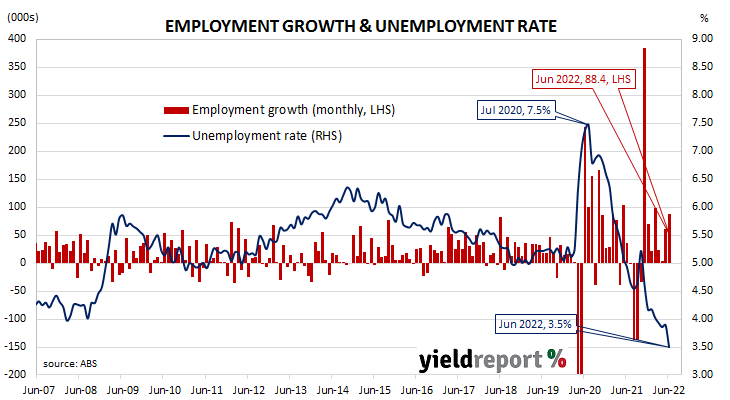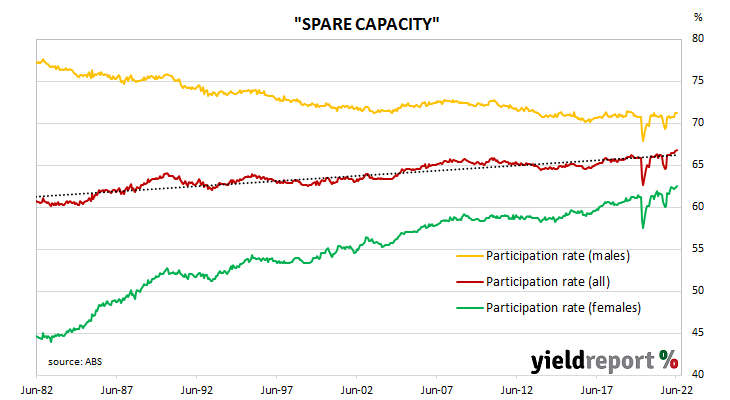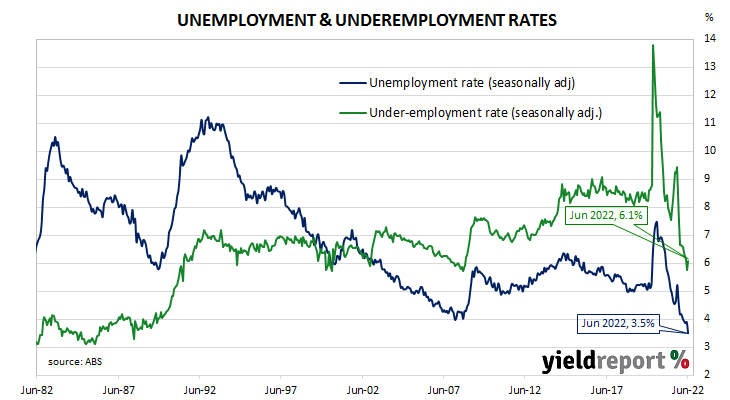Summary: Employment up 88,400 in June, noticeably greater than expected; little sign of RBA’s tightening coming through in near-term; “must be getting close” to full employment; participation rate ticks up to new record high; jobless rate falls to 3.5%; more part-time, full-time jobs; aggregate work hours steady; underemployment rate up from 5.7% to 6.1%.
Australia’s period of falling unemployment came to an end in early 2019 when the jobless rate hit a low of 4.9%. It then averaged around 5.2% through to March 2020, bouncing around in a range from 5.1% to 5.3%. Leading indicators such as ANZ’s Job Ads survey and NAB’s capacity utilisation estimate suggested the unemployment rate would rise in the June 2020 quarter and it did so, sharply. The jobless rate peaked in July 2020 but fell below 7% a month later and has since trended lower.
The latest Labour force figures have now been released and they indicate the number of people employed in Australia according to ABS definitions increased by 88,400 in June. The rise was noticeably greater than the 30,000 increase which had been generally expected and higher than May’s 60,600 increase.
“Importantly, labour demand indicators remain strong and point to further momentum in coming months; there is little sign of the RBA’s tightening coming through the labour market in the near-term,” said Morgan Stanley Australia economist Chris Read.
Short-term domestic Treasury bond yields jumped on the day. By the close of business, the 3-year ACGB yield had gained 11bps to 3.17% while the 10-year yield added 2bps to 3.45% and the 20-year yield finished unchanged at 3.70%.
In the cash futures market, expectations of a steeper path for the actual cash rate over time firmed considerably. At the end of the day, contracts implied the cash rate would rise from the current rate of 1.31% to 1.875% in August and then increase to 3.125% by November. May contracts implied a 3.735% cash rate while August 2023 contracts implied 3.685%.
“While we may not yet be at full employment as domestic labour supply continues to rise to new record highs and unemployment continues to fall, we must be getting close,” said Westpac senior economist Justin Smirk.
The participation rate ticked up from May’s figure of 66.7% to 66.8%, a new record high, as the total available workforce increased by 96,200 to 14.093 million, while the number of unemployed persons decreased by 54,200 to 493,900. As a result, the unemployment rate dropped from 3.9% to 3.5% as the lower jobless number was met by a larger number of people in the workforce.
The aggregate number of hours worked across the Australian economy remained unchanged even as 35,500 residents gained part-time positions and 52,900 residents gained full-time positions. In percentage terms, the total number of work hours remained steady after increasing by 0.9% in May. On a 12-month basis and after revisions, aggregate hours worked increased by 3.8% as 34,500 fewer people held part-time positions and 472,500 more people held full-time positions than in June 2021.
In recent years, more attention has been paid to the underemployment rate, which is the number of people in work but who wish to work more hours than they do currently. While June’s unemployment rate fell, the underemployment rate increased from 5.7% to 6.1%.
The underutilisation rate, that is the sum of the underemployment rate and the unemployment rate, has a strong correlation with the annual growth rate of the ABS private sector wage index when advanced by one quarter. June’s underutilisation rate of 9.6% corresponds with an annual growth rate of about 4.6%.




